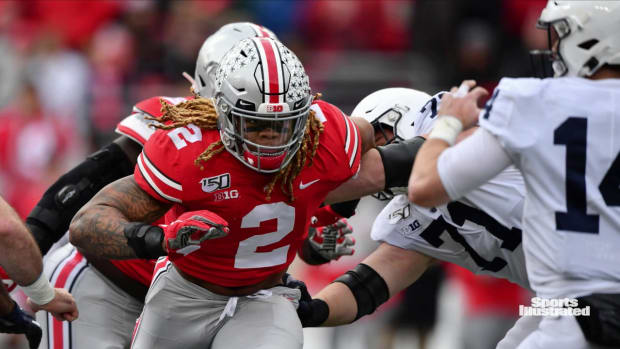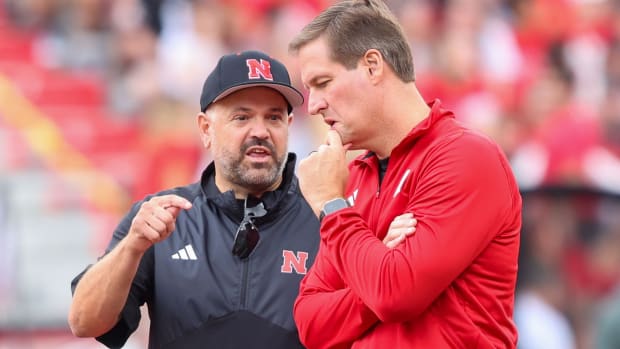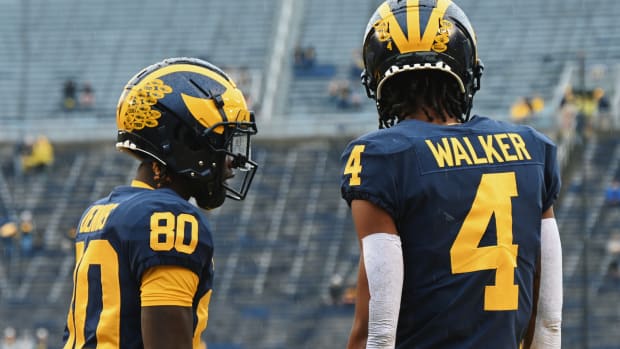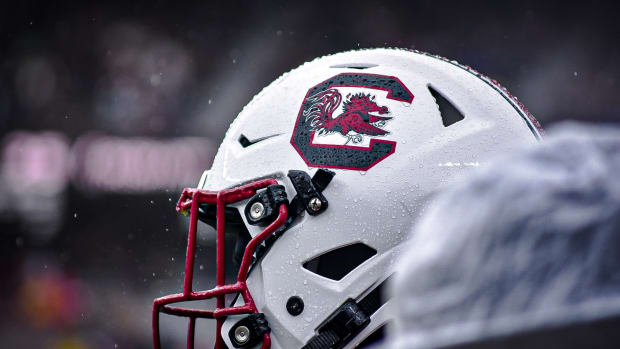Washington Is Giving Seattle a Reason to Party Like It’s the 1990s
The wind howled, whipping flags and trees and wrappers and leaves and even bodies in need of some extra holiday weight in the months upcoming. Didn’t matter. Rain threatened to soak Seattle and, by extension, Husky Stadium, where a dormant college football power has awakened to find a landscape unlike anything from its early 1990s zenith. Didn’t matter. “Experts” could rank the Huskies No. 5 nationally, unbeaten (10–0, 7–0 Pac-12) but not, if it started today, in the College Football Playoff. Didn’t matter. Skeptics could doubt whether quarterback Michael Penix Jr., a leading candidate to win the Heisman Trophy, could lead UW to a national title. Didn’t matter. The Huskies conference home, rival schools and travel budgets will all change next season, when UW moves to the Big Ten. Didn’t matter.
Nothing did. Not one thing, not even a little bit. The enthusiasm of 70,976 (mostly) purple-clad enthusiasts who trekked here—despite foul weather, bone-chilling cold, incessant “disrespect”—could not be dimmed. It felt like 1991 all over again, from the streets packed with cars to the parade of purple to no empty seats to in-game music selection. Yes, on Saturday, as Washington ground out a 35–28 win over Utah, even the students from Generation Z went full grunge, strengthening the theme.
All that and, of course, this remarkable season, more than anything. This UW football season is context (from before) and history (at stake). It’s the infusion of new blood and the transformation of a power decades in the making. All have combined to trigger the best kinds of memories for locals of a certain age range, from a time where college football in Seattle mattered more than any other sport year-round.
Sure, on Saturday large branches lay everywhere, dotting roads and driveways and sidewalks, each ripped off by the wind, which bent trees sideways, as if they wanted to lean into something. Parking lots became fight clubs with available space so prized that lots in close proximity to the stadium could have charged 50 times the normal price.
But this marked a fall Saturday in Seattle, with major college football on tap, beautiful red-orange-yellow leaves on trees and the currently most dominant local sports team suddenly worth leaning into (tree-in-wind style), as the mighty bandwagon that once held a city’s worth of fans under its spell continued to fill back up. So they came, the Dawgs. Of course they did. Imagine how many years have passed since they had this kind of choice.
Anyone who opened their eyes after closing them half expected to see Kurt Cobain outside the stadium, smashing a guitar. The vibe was that magical, that dated—and that distinct. Washington, ranked fifth and bunched close with those above them, would host Utah, ranked No. 18. Both helped the Pac-12 form its strongest football slate in years, with Oregon, Oregon State and USC all ranked high at various points this season and with all five of those teams formidable.

The Huskies forced two Utah turnovers and held the Utes scoreless in the second half.
Steven Bisig/USA TODAY Sports
None of those five programs entered Saturday ranked as high as UW, which survived Oregon in a thriller on Oct. 14, waved goodbye to its high-powered offense for a win over Arizona State, out-scored Stanford in a victory where its defense failed and then turned the offensive jets back on against USC. That stretch pointed toward the same conclusion: that, while the Huskies hadn’t lost before Saturday and appeared capable of challenging for a coveted playoff spot, they also haven’t exactly steamrolled every team in front of them.
And this team, the one in front of them this Saturday, presented a riddle that elevated anxiety across the Puget Sound. Utah was the underdog, but these Utes can play. They blew out Arizona State and featured a strength—a thudding, tackling, devouring defense—that seemed perfectly tailored to counter UW’s typical eruption tallies (points, touchdowns, defenders unable to do anything but shake their heads).
Consider their clash, then, the most important college football game held here in at least seven seasons. At least. There were two jet flyovers, in honor of Veteran’s Day. Scalpers, freezing and profiting simultaneously. Boats, docked off shore without a stadium view, there for the vibe, for the roars alone. This isn’t just any season, either; it’s the final season for the Conference of Champions, at least in its current, 12-team form. Which only added to everything else.
The Huskies needed only one thing Saturday. It wasn’t Nirvana. It wasn’t ticket revenue. It wasn’t even the vibes that recalled the program’s best-ever teams. No, what Washington needed, more than anything, was to win.
UW nearly made the wrong kind of history instead. Start there, midway through the third quarter, after Washington teetered and struck and wobbled and re-centered. These Huskies kept after Utah, and kept coming, until a bizarre third quarter sequence turned a sold-out Husky Stadium into a grungy, purple mosh pit of elation and disappointment and then confusion.
The sequence started in the usual place, with quarterback Michael Penix Jr., who found wideout Rome Odunze for a 44-yard gain that set up a field goal and trimmed the Utes lead to 28–27. The Huskies then forced a Utah punt. Penix then found Odunze again, and with ideal field position, this 33-yard reception put UW back ahead, 33–27, after its two-point conversion failed.
That’s when a song familiar to every middle-aged Seattleite (and, of course, many millions more) blared over the stadium speakers. Nirvana, naturally: “Smells Like Teen Spirit.”

Odunze hauled in three catches for 111 yards and two scores against Utah on Saturday.
Steven Bisig/USA TODAY Sports
The afternoon kept taking weird turns from there. The Utes sped right back down the field, undeterred, even as Husky Stadium shook from so many stomps and strained vocal chords and roars. Utah advanced to UW’s 14-yard-line. But after a holding penalty, quarterback Bryson Barnes threw into a space where he didn’t seem to see a defender lurking. It was linebacker Alphonzo Tuputala who spied the trajectory, stepped in front of the intended target and picked the ball off. At that second, he saw nothing but green turf between him and the purple end zone with “HUSKIES” spelled out in giant gold letters. He took off, sprinting up the field, traversing the 77 yards between his pick and his pay-off.
Only one problem remained. Tuputala traversed those yards alright. But he carried the ball for only 76 of them, dropping it on the 1-yard-line like the earliest of Christmas presents, where Utah ultimately recovered. The gaffe was striking for a lot of reasons—for the momentum seized, then given back; for the victory secured, then dropped, literally, back into question; and for where he put the ball down, at the 2-yard line almost, with two full steps before the end zone.
“It’s a great lesson,” Washington coach Kalen DeBoer said afterward, while noting that teammates continued to attempt to lift the linebacker’s spirit on the sidelines. “But, fortunately, you win the football game.”
Right then, anyone old enough to remember considered those ‘90s vibes more closely. After all, nobody knows which early-’90s season this one will most resemble.
Will it be like ’90, when UW exceeded expectations and wasn’t quite national title good?
Or ’92, when vast promise dissolved into three losses in the final four games?
Or ’91, when UW didn’t lose, not once, and staked its legitimate, pre-playoff claim as college football’s national champion? No purple people here consider that title split. Nor would a single person choose any other season to replicate, right now.
Whether the gift dropped by the linebacker on the 1-yard-line would change a program’s history remained up for debate.
One year and one month had flown by since the last time Washington lost a football game, which happened on Oct. 8, 2022, in the desert, against Arizona State. The Huskies won each of their 16 subsequent contests, via blowouts and close calls survived and every kind of victory in between. What was clear—and far more consistent—is that in Kalen DeBoer, Washington hired the right coach.
DeBoer long ago began carving a reputation as a coach who made teams better, who won, wherever he went, whether at Sioux Falls, Southern Illinois, Eastern Michigan or Fresno State. He worked at the last stop twice: as the Bulldogs offensive coordinator in 2017 and ’18 and as their head coach in ’20 and ’21. In those final two years, his first two as a Division I head coach, he lifted Fresno State back to respectability (3–3 in COVID-19-shortened ‘20 sure beat 4–8 the year before) and then back into a bowl game.
His hire, for once, came with little backlash, understandably, and his first season proved that none was necessary. The Huskies won 11 games, finished the year ranked eighth nationally and stumbled only twice, against ranked teams in UCLA and ASU. Late Saturday, in comparing this season to last season, DeBoer said, of those losses, “We weren’t able to work through them.”
Could they work through Utah? They needed to, for several reasons—most notably, to keep the playoff dream alive, while handing the Utes a third defeat, which would effectively end Utah’s chances to win the conference. But while Washington avenged its loss to Arizona State with a 15–7 win on Oct. 21, the Utes, against the same Sun Devils only a week earlier, won by 52 points.
The stakes elevated higher than Mt. Rainier, forever looming in the distance. They led to the first warning for loud decibels at 12:36 p.m. locally, or right after the game kicked off.
The lead-up leaned heavily into the obvious narrative: strength vs. strength. Utah ranked ninth nationally in scoring defense, allowing 15.9 points per game. Washington ranked first in passing production and fourth in average points (41.7). This clash signaled one of the early tunes the stadium deejay played–Whomp! (There It Is).
Instead of strength vs. strength, though, the teams skirmished in lockstep. In the first half, both defenses struggled, mightily, as yards and points piled up but no rain fell. After one quarter, Washington led, 10–7. After two quarters, Utah led, 28–24.
The history between these programs hinted at another upset brewing. It’s not that Utah dominates its modest non-rivalry with UW. But the Utes have notched a couple upsets in recent years—and both came in Seattle (2015, ’19), in Husky seasons of great promise.
After halftime Saturday, the Huskies needed to stamp out those concerns. It would be difficult to complain about respect or rankings or resumes if their record didn’t match those held by Ohio State, Georgia, Michigan and Florida State. The flip side of that calculus also mattered though, because with Utah and Oregon State—two top-20 teams—back-to-back, Washington could bolster its record, its resume and, in all likelihood, its ranking before the Pac-12 championship game, especially after out-gunning USC in Los Angeles the week before.
But that gaffe! It threw all aims into question, adding tension, suspense and, for the honest ones in the crowd, more than a little concern. Utah took over, back up into its end zone, ball nosed on the 1-yard-line. The Utes tried a handoff to Ja’Quinden Jackson, the Texas transfer with nearly 600 rushing yards on the season, and when Jackson tried to slip forward, the Huskies pulled him down in the backfield instead. The safety made it 35–28, in favor of UW, but the theatrics weren’t over, not by a long shot.
Two teams that traded points and touchdowns in the first half swapped stops in the second. Washington punted after the safety. Utah punted after that.
Penix entered Saturday with 3,201 passing yards on the season, the highest tally in the country, despite an unorthodox delivery, so many bombs slung left-handed, almost sidearm. Don’t mistake different for worse, though. He’s strong, and he’s accurate, as evidenced by the half dozen NFL scouts set up in the press box, Seahawks general manager John Schneider among them. (Funny side note: his wife dropped him off at the game.)
The quarterback sped UW’s offense down field, as the sun dropped toward the horizon, same as Utah’s chances. Until! With the Huskies only six yards from putting a much-needed victory in cement, the Utes dropped him for a third-down sack. This set up a sure field goal attempt from 32 yards out. But as the purple people began a premature celebration, kicker Grady Gross lined up to extend the lead to 10—and, somehow, no way, that-really-happened … missed.
Utah had one final chance, a gift on a day when UW handed over the odd and the oh my. The Utes drive started at their own 18-yard-line, and Penix paced so far he ended up at the far other end of the field. He didn’t need to worry about staying warm, though. The Huskies saved the playoff portion of their season with an interception.
“I’m just proud of the guys,” DeBoer said. “That’s where we’re at right now. They found a way to win.”
Their reward? Oregon State next week, on the road.
There’s an easy case to make for the ‘90s as Seattle’s heyday, the Emerald City’s prime. It can sound cliché, this notion, especially given the elements necessary to make that argument. But the best clichés are often the most accurate, no?
Consider: in Seattle, in the ‘90s, grunge music was taking over the universe. Pioneers included iconic bands like Pearl Jam and Nirvana, but to only feature those two sells that scene impossibly short. The uninitiated, the newbies or the youth might want to check out Soundgarden, Alice in Chains, Mudhoney, Tad, Temple of the Dog, Green River and Mother Love Bone. You’re welcome. But that’s not all …
Consider: in Seattle, in the ‘90s, the sports scene pretty much ascended to its peak. The Sonics threatened for NBA championships regularly, before they were stolen by robber barons and moved to Oklahoma City (sigh). Shawn Kemp was throwing down thunder dunks that shook the Space Needle. Gary Payton was lobbing alley-oops, pick-pocketing opposing point guards and talking s—t, the combination of which injected much-needed swagger into local sports. The Mariners were entering the best stretch in club history, with Ken Griffey Jr. enticing a generation of local sports fans to wear hats backward, Edgar Martinez slapping singles and Griffey famously sliding into home. The Seahawks were still bad then, but at least they featured the best uniforms in the NFL and were building, bolstering support for a new stadium under Dennis Erickson and hiring Mike Holmgren to replace him and fully realize the change ahead.
The ‘90s came to matter more in 2023, in one place, with one team on the modern Seattle sports scene. That decade began resonating more and more deeply, because of this team, in this place; because, while Washington football has produced many strong seasons since its own ‘90s heyday, it hasn’t had one like this since. Sure, there have been many bowl games for UW, 19 so far in the 30 seasons since the era to end all Husky football eras halted abruptly, when Don James resigned amid a recruiting scandal shortly before the ’93 campaign. But reaching middling bowl games—among them; each ending in “bowl:” The Heart of Dallas, Cactus, Fight Hunger, Las Vegas, Sun, Freedom, Aloha—is not the same thing as stitching together special seasons. UW had a few of those, too: a Rose Bowl loss in 2000 that marked the height of Rick Neuheisel’s tenure; a College Football Playoff semifinal loss, after the ’16 season, under Chris Petersen; and another Rose Bowl defeat, also under Petersen, two years later.
But the program never again approached the dizzying heights of yesteryear, the glorious three-season stretch from 1990 through ’92. The Huskies reached the Rose Bowl in each of those seasons, winning twice, when that bowl game marked the ultimate Pac-then-10 prize. They lost only five games in all three years combined. And ’91, for now and for as long as it takes any team to stake another claim, will be remembered as the greatest season in program history, hands down – from the record (12–0) to what it birthed (a split/disputed national championship).
That year also marked the last time a Washington football team won its first nine games (UW stumbled in their ninth contest in ’92 and fourth in ’90). So, yeah, rain and wind and cold and doubt and doubters and an unblemished record that still had the Huskies just outside of most playoff projections didn’t dim the enthusiasm present Saturday. Oh, no. If anything, it infused the collective spirit of those who formed a sea of purple gathering beside Lake Washington, where, on the other side of the stadium, Montlake Boulevard E. runs toward campus.
To say that Montlake is always under construction is to say that rain dribbled from the skies Saturday morning. It’s expected. But the Huskies, their program perpetually immersed in its own rebuilds, provided the twist.
Construction szn under Kalen DeBoer is over. Demolition szn has begun.
The working theme, per Seattle city ordinance, must be borrowed from a Nirvana song title.
How about … In Bloom?






